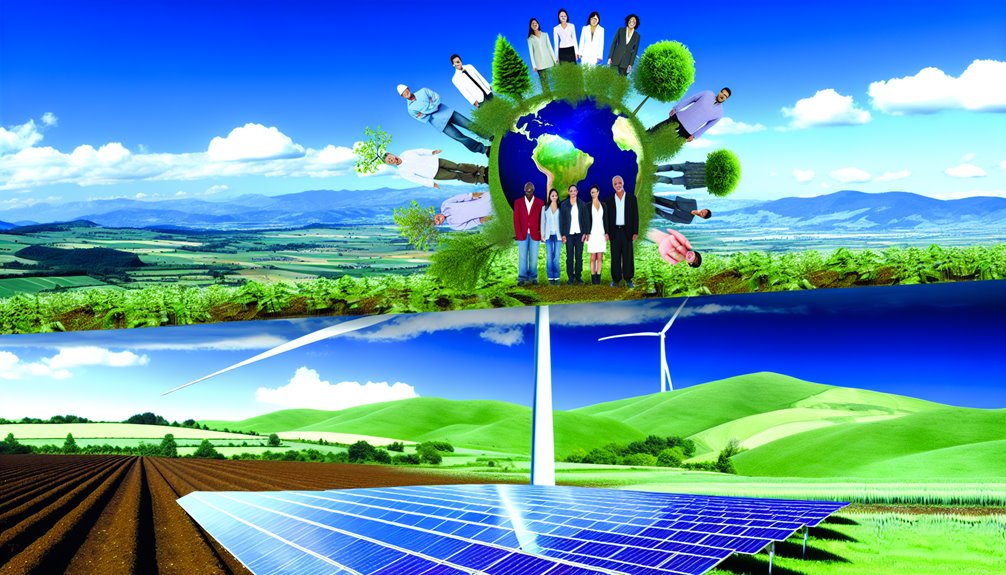Sustainable Growth: Definition and Meaning
Did you know that over 70% of global GDP is generated by countries committed to sustainable growth? This statistic underscores the importance of balancing economic progress with environmental and social considerations. You should explore how sustainable growth definition and its success beyond traditional metrics, emphasizing resilience and inclusivity. It is crucial to understand the core principles driving this shift and their implications for future policy and economic strategies. What are the key challenges and opportunities ahead?
Understanding the Core Principles of Sustainable Growth
While considering the complexities of modern economies, understanding the core principles of sustainable growth becomes vital to fostering long-term prosperity.
You need to examine growth metrics that prioritize both economic development and resource efficiency. Sustainable practices like circular economies and renewable energy adoption are essential. They guarantee that economic activities don’t compromise future generations’ ability to meet their needs.
By analyzing GDP alongside metrics such as carbon intensity and resource utilization rates, you can identify whether growth is genuinely sustainable.
Policy frameworks should incentivize low-impact technologies and encourage businesses to integrate sustainability into their operational models for enduring economic stability.
The Environmental Dimension of Sustainable Growth
Although economic growth remains essential, the environmental dimension of sustainable growth can’t be overlooked.
Prioritizing biodiversity conservation leads to resilient ecosystems, which provide services worth approximately $125 trillion annually. You should advocate for policies that protect habitats and species, as their decline threatens these valuable services.
Shifting to renewable energy is equally important. Solar and wind energy have seen costs drop by 89% and 70% respectively over the past decade, making them viable economic alternatives.
Social Impacts and the Role of Equity in Sustainable Growth
Addressing the social impacts and role of equity in sustainable growth is essential for building inclusive economies.
You need to implement inclusive policies that prioritize social equity and equitable development. Data shows that participatory governance can empower communities, especially marginalized groups, by reducing access disparities.
By focusing on community empowerment, you can guarantee that all voices are heard, promoting social justice. Policies should analyze demographic data to identify and address the needs of different groups, guaranteeing no one is left behind.
A commitment to equitable development fosters a resilient society, where sustainable growth is shared equitably across all communities.
Economic Aspects of Achieving Sustainable Growth
Understanding the economic aspects of achieving sustainable growth requires a thorough approach that aligns with social equity principles.
You must implement robust economic policies promoting sustainable finance and investment strategies focused on green technologies.
Innovation ecosystems play a significant role in facilitating market incentives that encourage businesses to adopt sustainable practices.
By fostering economic resilience, you’ll enhance the adaptability of markets to unforeseen challenges.
Embracing a circular economy model will guarantee resources are efficiently utilized and waste minimized.
Data-driven strategies are essential for evaluating the effectiveness of these approaches, ensuring they contribute to long-term economic stability and equitable growth.
The Importance of Resource Management in Sustainable Development
Effective resource management is vital in sustainable development because it guarantees the long-term availability and viability of critical assets. You need to focus on strategic resource allocation and waste reduction to maximize efficiency.
Implementing conservation strategies and sustainable practices guarantees that renewable resources remain intact. Ecosystem management plays a pivotal role in maintaining biodiversity and ecological balance.
By adopting a circular economy model, you can minimize waste and promote resource reusability. Community engagement is essential to foster awareness and cooperation, guaranteeing that sustainable goals are collectively achieved.
Data suggests these integrated approaches greatly enhance resilience and support sustainable growth.
Challenges and Barriers to Achieving Sustainable Growth
Despite the clear benefits of sustainable growth, numerous challenges and barriers persist that hinder its achievement.
Regulatory hurdles often create complex compliance landscapes that stifle innovation.
Technological limitations delay the adoption of efficient solutions.
Financial constraints restrict investment in necessary infrastructure, exacerbating infrastructure challenges.
Public awareness remains low, leading to market resistance and a lack of consumer demand for sustainable products.
Policy inconsistencies between regions create global disparities, complicating cooperative efforts.
Without cohesive strategies, these issues persist, making it difficult for stakeholders to navigate the path towards sustainable growth effectively.
Addressing these barriers is essential for meaningful progress.
Key Strategies and Approaches for Promoting Sustainable Growth
To promote sustainable growth effectively, stakeholders must prioritize a multifaceted approach that leverages policy innovation, technological advancement, and financial investment.
Deploy renewable energy sources to reduce carbon footprints and integrate green technology to enhance energy efficiency.
Foster a circular economy by maximizing resource lifecycle, minimizing waste, and encouraging community engagement for collective action.
Policy innovation should incentivize sustainable finance to fund eco-friendly initiatives.
Urban planning must incorporate biodiversity conservation, ensuring ecological balance in expanding cities.
Data shows cities implementing these strategies see enhanced resilience and economic stability, proving the critical role of holistic approaches in achieving sustainable growth goals.
The Future of Sustainable Growth: Trends and Opportunities
As we look toward the future of sustainable growth, emerging trends and opportunities suggest a transformative shift in economic and environmental paradigms.
Green technology is advancing rapidly, with significant investments driving innovation in renewable energy and efficient resource use.
Policymakers are prioritizing the circular economy, emphasizing waste reduction and resource reuse to mitigate environmental impact. Data indicates a 30% increase in global circular economy initiatives over the past five years.
By integrating these approaches, you can tap into new markets and enhance competitiveness.
The future will be shaped by policies that support sustainable practices, balancing economic growth with environmental stewardship.
Conclusion
In your journey toward sustainable growth, remember that it’s not just about crunching numbers like a 90s stockbroker. You need to prioritize integrating renewable energy, promoting social equity, and managing resources wisely. Despite challenges, data shows that adopting circular economies can boost GDP by up to 4%, while inclusive policies enhance community resilience. Focus on these strategies to build a future where prosperity and environmental health coexist, ensuring long-term benefits for both current and future generations.
Read more on >>>





